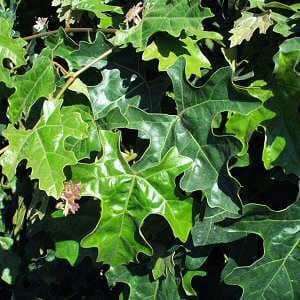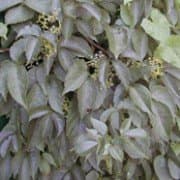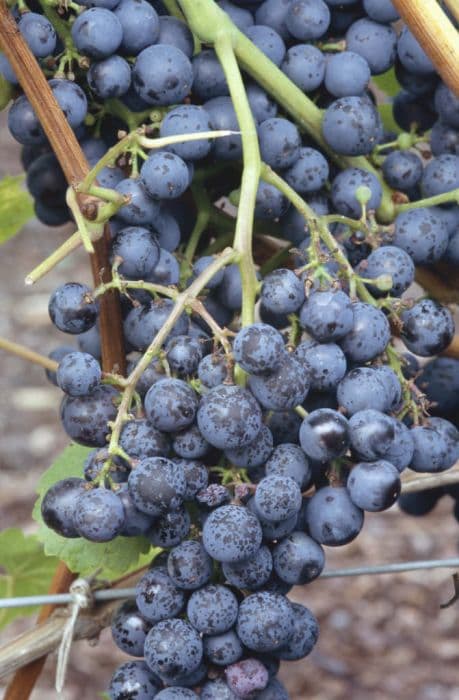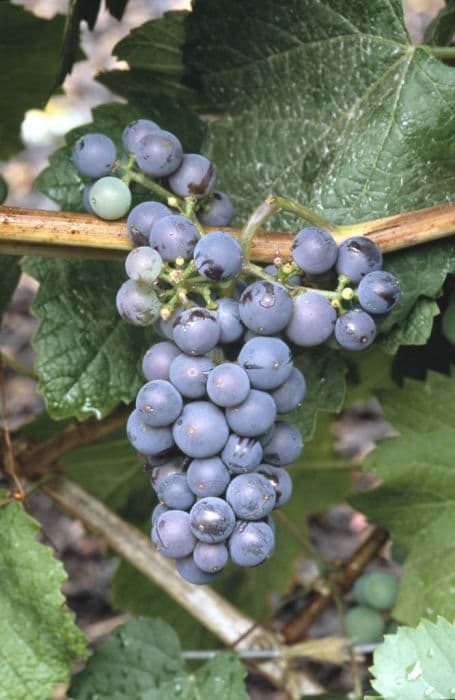Pinot Noir Grape Vitis vinifera 'Pinot Noir' (O/b)

ABOUT
Pinot Noir is a variety of grapevine that is typically trained to grow on trellises to support its structure, as it can become quite heavy with fruit. The vines themselves are woody and can be quite twisted and gnarled with age, often requiring careful management and pruning to maintain their health and productivity. The leaves are broad, typically five-lobed, with a toothed margin, and emerge in a bright green hue that deepens as they mature. The underside of the leaves can have a slightly fuzzy texture. During the growing season, the vine produces clusters of small green flowers which eventually give way to the grape bunches. The grapes are the most distinctive feature of the Pinot Noir vine, small to medium in size with a thin skin, ranging in color from a blueish-purple to nearly black when ripe. They are tightly clustered, often resembling pine cones, and their sweet flavor is highly prized for winemaking. In the fall, the leaves can turn vibrant shades of yellow, orange, and red, adding an ornamental quality to the vineyard before they drop, signaling the end of the growing season.
About this plant
 Names
NamesFamily
Vitaceae
Synonyms
Pinot Noir, Burgundy, Spätburgunder, Blauburgunder, Pinot Nero
Common names
Vitis vinifera 'Pinot Noir'
 Toxicity
ToxicityTo humans
Grapevines, which include Pinot Noir, are not considered toxic to humans. The fruits, or grapes, are widely consumed with no adverse effects when eaten in moderation. However, other parts of the plant such as leaves and stems are not typically consumed by humans, and there may be risks involved if large quantities are ingested due to the presence of various plant compounds. Unripe grapes and grape seeds contain tannins and other compounds that could potentially cause stomach upset if consumed in large quantities. Consuming extremely large amounts of grape leaves or stems could lead to adverse effects such as diarrhea, nausea, or vomiting, but such instances are rare and generally associated with the ingestion of unusually large quantities which is not common.
To pets
Grapevine, specifically the grape, is toxic to dogs and cats. The toxicity is not fully understood, but ingestion of grapes can lead to acute kidney failure in pets. Signs of grape or raisin toxicity may include vomiting, diarrhea, lethargy, abdominal pain, decreased appetite, and kidney failure, which can be identified by a decrease in urine production. It is important for pet owners to recognize that even small quantities of grapes or raisins can be highly toxic to some pets and seeking immediate veterinary care is crucial if ingestion occurs.
 Characteristics
CharacteristicsLife cycle
Perennials
Foliage type
Deciduous
Color of leaves
Green
Flower color
Greenish-yellow
Height
10-15 feet (3-4.6 meters)
Spread
3-4 feet (0.9-1.2 meters)
Plant type
Climber
Hardiness zones
7-9
Native area
Mediterranean
Benefits
 General Benefits
General Benefits- Production of Pinot Noir grapes for high-quality wines: Vitis vinifera 'Pinot Noir' is renowned for its premium grapes used in the production of Pinot Noir wines, which are appreciated worldwide for their distinct aromas and flavors.
- Aesthetic appeal for landscapes and gardens: The vine's lush foliage and growth habit make it an attractive addition to garden trellises, arbors, and fences, enhancing the beauty of outdoor spaces.
- Economic importance in the wine industry: This variety of grapevine is crucial for wine producers and contributes significantly to the economies of wine-producing regions.
- Cultural and historical significance: Pinot Noir has a storied history and is deeply intertwined with the traditions and heritage of regions famous for its cultivation and wine production.
- Habitat for wildlife: These vines can provide habitats and food sources for various species of birds and insects, contributing to local biodiversity.
- Educational value: Vitis vinifera 'Pinot Noir' serves as an educational tool for viticulture studies, demonstrating grape growing techniques, and wine production processes.
- Recreational activities: Vineyards offer recreational opportunities like wine tasting tours, vineyard walks, and harvest festivals that enrich local tourism.
- Shade and microclimate control: When grown in larger areas, these vines can create shaded environments and help regulate local microclimates, which can be beneficial in hot regions.
 Medical Properties
Medical Properties- Antioxidant: Pinot Noir grapes contain flavonoids and resveratrol, which have antioxidant properties and may help reduce oxidative stress in the body.
- Cardiovascular health: The polyphenols in Pinot Noir grapes, notably resveratrol, have been associated with a lower risk of heart disease and improved vascular function.
- Anti-inflammatory: Components of Pinot Noir grapes can have anti-inflammatory effects, potentially beneficial for reducing chronic inflammation in the body.
 Air-purifying Qualities
Air-purifying QualitiesThis plant is not specifically known for air purifying qualities.
 Other Uses
Other Uses- Grape leaf sachets: Pinot Noir grape leaves can be dried and used to create aromatic sachets that impart a subtle fragrance to clothing and linens.
- Homemade dyes: The skins of Pinot Noir grapes can be used to create natural dyes for fabric or artisanal paper products.
- Cooking ingredient: Red wine made from Pinot Noir grapes can be reduced to make a rich syrup for desserts or as a complex flavor base for sauces and marinades.
- Grape seed oil: The seeds of Pinot Noir grapes can be pressed to extract oil that is used in gourmet cooking and as a base for salad dressings.
- Vine cuttings crafts: Pruned vines from Pinot Noir plants can be crafted into wreaths, baskets, or artistic sculptures for home décor.
- Educational tool: Pinot Noir plants can be used in botany and viticulture programs to teach students about plant biology and grape cultivation.
- Photography subject: The picturesque Pinot Noir vineyards are often used as a scenic backdrop for photography and film, capturing the beauty of the grapevines.
- Erosion control: The extensive root system of Pinot Noir vines can help prevent soil erosion in hilly agricultural areas.
- Natural compost: Spent grape pomace from Pinot Noir wine production can be composted and used as a nutrient-rich soil amendment in gardens.
- Wildlife habitat: The dense foliage and structure of Pinot Noir vines provide habitats and nesting sites for various bird species and beneficial insects.
Interesting Facts
 Feng Shui
Feng ShuiThe Grapevine is not used in Feng Shui practice.
 Zodiac Sign Compitability
Zodiac Sign CompitabilityThe Grapevine is not used in astrology practice.
 Plant Symbolism
Plant Symbolism- Luxury and Wealth: As the source of high-quality wine, Pinot Noir grapes often symbolize luxury and wealth due to the cultural status of fine wines and the value attached to them.
- Celebration and Joy: Wine made from Pinot Noir grapes is commonly associated with celebration and joy, being a frequent choice for toasts and special occasions.
- Fertility and Abundance: Vineyards themselves are symbols of fertility and abundance, and by extension, the Pinot Noir grape, a plentiful harvest, is suggestive of productiveness.
- Transformation and Potential: The process of turning Pinot Noir grapes into wine signifies transformation and the potential for change, reflecting life’s various phases.
- Earth Connection: Cultivation of Pinot Noir grapes is sensitive to terroir, emphasising a deep connection to the earth and the environment.
 Water
WaterThe Pinot Noir grapevine requires deep watering to establish a strong root system, particularly during the growing season. It's best to water this plant deeply but infrequently, allowing the soil to dry out slightly between watering. A rough estimate is to provide about 1 inch of water per week, which equates to approximately 0.62 gallons per square foot monthly. During hot, dry spells, it may be necessary to water more frequently, and established vines may require less water. Ensure that the water reaches the root zone, which is around 1 foot deep.
 Light
LightPinot Noir grapevines thrive in full sunlight to produce the best fruit. They should be planted in a location where they can receive at least 6 to 8 hours of direct sunlight per day. Avoid areas that are shaded for significant parts of the day, as insufficient light can hinder fruit production and affect the quality of the grapes.
 Temperature
TemperaturePinot Noir grapevines grow best in a temperature range of 55 to 85 degrees Fahrenheit, with a dormant winter period that should not exceed a sustained temperature below 20 degrees Fahrenheit. Ideal growing conditions include warm days and cooler nights but protect the vines from frost, as temperatures below 28 degrees Fahrenheit can cause significant damage.
 Pruning
PruningPruning is crucial for the health and productivity of Pinot Noir grapevines. It should be performed during the dormant season, typically in late winter, to shape the vine and control its growth. Prune annually to remove dead or overcrowded branches, which helps improve air circulation and sunlight exposure, essential for quality grape production.
 Cleaning
CleaningAs needed
 Soil
SoilThe best soil mix for the common grapevine, Pinot Noir, is well-draining with some organic matter. A pH level of 5.5 to 6.5 is ideal for nutrient uptake.
 Repotting
RepottingGrapevines like Pinot Noir are typically not repotted as they are perennial vines grown outdoors; instead, they are planted directly into the ground.
 Humidity & Misting
Humidity & MistingPinot Noir grapevines are versatile but prefer moderate humidity levels, avoiding excessive moisture which can promote fungal diseases.
 Suitable locations
Suitable locationsIndoor
Ensure full sunlight, support for climbing, and well-drained soil for indoor Pinot Noir.
Outdoor
Provide full sun, support for growth, and well-draining fertile soil for outdoor Pinot Noir.
Hardiness zone
7-9 USDA
 Life cycle
Life cycleThe life cycle of 'Pinot Noir' grapevines (Vitis vinifera 'Pinot Noir') begins with bud break in early spring, where tiny buds on the vine start to swell and produce shoots. Following bud break, flowers develop and bloom, usually around late spring, which are self-pollinating and eventually form grape clusters. Throughout the summer, these grape clusters go through veraison, a stage where grapes change color and begin to ripen. Harvest of the 'Pinot Noir' grapes typically occurs in late summer to early fall, depending on the climate and desired ripeness. After harvest, the vines enter a period of dormancy over the winter months where they store energy for the next growing season. This yearly cycle continues throughout the life of the grapevine, which can live and produce fruit for several decades with proper care.
 Propogation
PropogationPropogation time
Spring-Early Summer
Propogation: For the Vitis vinifera 'Pinot Noir', most commonly known as Pinot Noir grapevine, the most popular method of propagation is through hardwood cuttings. This usually takes place during the plant's dormancy period in late winter or early spring. Cuttings about 12 to 18 inches (30 to 46 centimeters) in length, containing two to three buds, are taken from healthy, one-year-old canes. The base of the cuttings is then treated with a rooting hormone to encourage root development and planted in well-draining soil with good sun exposure. They need to be kept moist until the cuttings have established a strong root system, after which they can be transplanted to their permanent location in the vineyard.



![Grape [Claret Cloak]](/_next/image?url=https%3A%2F%2Fplants-admin.emdemapps.com%2Fimages%2Fplants%2F%2Fimages%2F604b602abe2f8.png&w=640&q=75)





